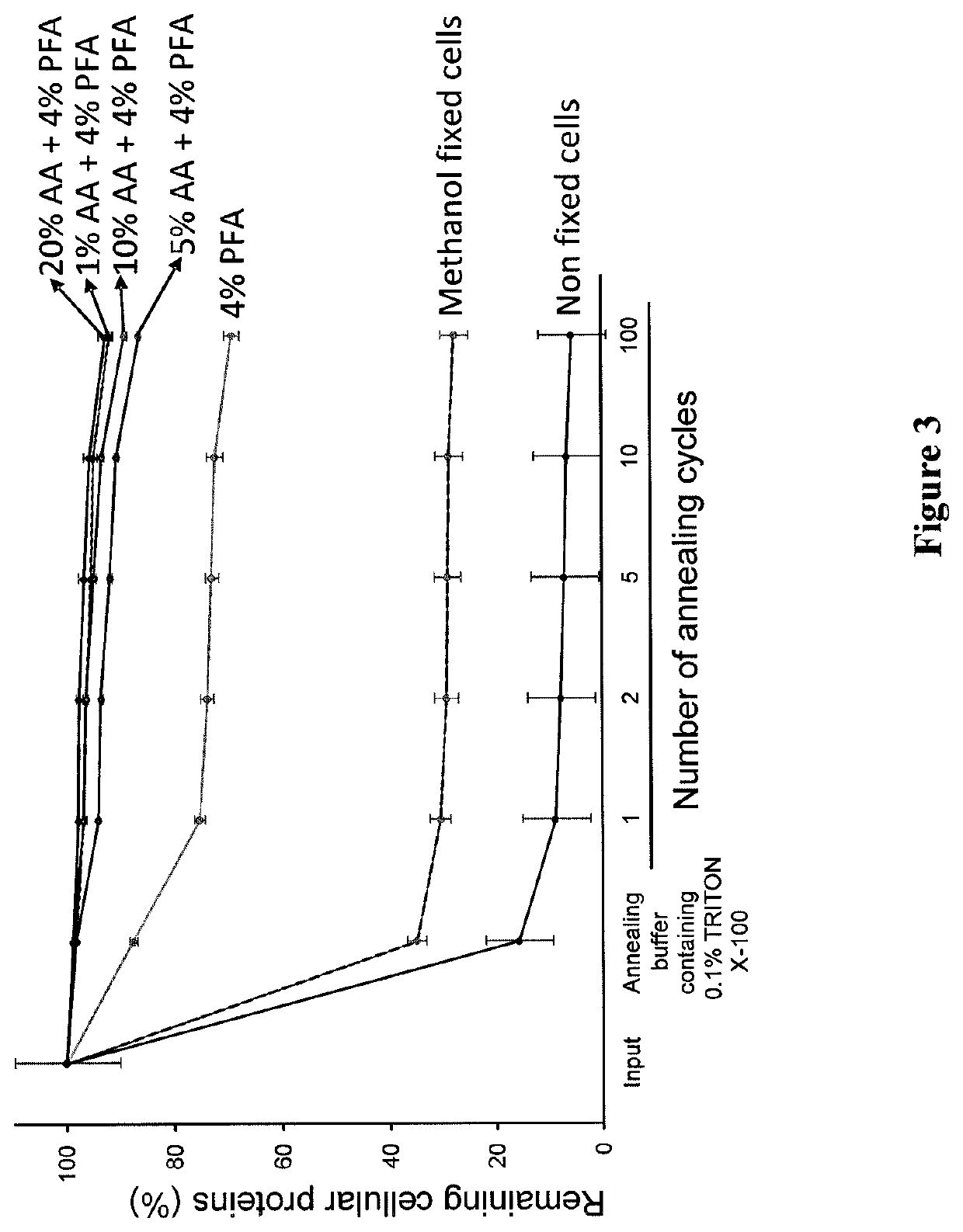Methods of preparing a re-usable single cell and methods for analyzing the epigenome, transcriptome, and genome of a single cell
a single cell and cell genome technology, applied in the field of preparing a reusable single cell and methods for analyzing the epigenome, transcriptome, and genome of a single cell, can solve the problems of many single cells not being re-used, high error rate of methods for amplifying and sequencing a cell genome, and inability to study dna-bound proteins, rna-bound proteins, and dna-bound proteins simultaneously
- Summary
- Abstract
- Description
- Claims
- Application Information
AI Technical Summary
Benefits of technology
Problems solved by technology
Method used
Image
Examples
example 1
[0124]This example demonstrates a method of preparing a re-usable single cell by anchoring the cellular components inside the single cell with a polyacrylamide nano-scale scaffold.
[0125]A diagram illustrating an embodiment of the inventive method for preparing a polyacrylamide nano-scale scaffold of the invention is provided in FIG. 1. To prepare the polyacrylamide nano-scale scaffold, 1×106 MS1, or K562 cells were dispersed in a phosphate-buffered saline solution comprising 4% formaldehyde (PFA) and either 1%, 4% 5%, 10%, 20% acrylamide, or 28% acrylamide. The dispersed cells were held for one hour on ice to allow the PFA and acrylamide to bind to the cellular proteins, followed by washing the dispersed cells with Tris buffered saline (TBS) solution to remove free PFA and free acrylamide. The cells were pelleted by centrifugation, the TBS was removed, and the cells were resuspended in a solution containing 1% sodium ammonium persulfate, and 4% acrylamide-bisacrylamide or 4% acrylam...
example 2
[0127]This example demonstrates that cellular components anchored by the polyacrylamide nano-scale scaffold are accessible to antibodies.
[0128]K562 cells were embedded in a polyacrylamide nano-scaffold prepared utilizing 20% acrylamide and 4% acrylamide-bisacrylamide, as described in Example 1. Once the polyacrylamide nano-scale scaffold was polymerized, the oil was removed, and the cells were incubated in 1% TRITON X-100 (“the surfactant” Dow Chemical Company, Midland, Mich.) for at least 15 minutes. Incubation in the presence of surfactant permeabilizes the cells and allows buffers and reagents to enter the cells. The cells were then immersed in annealing buffer (20 mM Tris-HCl, pH 8.8, 10 mM (NH4)2SO4, 10 mM KCl, 0.1% surfactant) and 0.2 to 20 μM of the first oligonucleotide primer. The cells were then heated at 94° C. for 3 minutes. To avoid non-specific binding of antibodies the cells were transferred to 12.5 mM EDTA containing 2.5% bovine serum albumin (BSA) and 1% surfactant....
example 3
[0130]This example demonstrates that the polyacrylamide nano-scale scaffold retains proteins inside a single cell even after repeated heating and cooling cycles, thereby generating a “re-usable” single cell.
[0131]The experiments in this Example were performed to determine the effect of the polyacrylamide nano-scale scaffold on the retention of proteins in a single cell. A polyacrylamide nano-scaffold was prepared using 1×106 K562 cells utilizing methanol, 4% formaldehyde (PFA), 4% PFA with 1% acrylamide, 4% PFA with 5% acrylamide, 4% PFA with 10% acrylamide, 4% PFA with 20% acrylamide, or no fixative, and 4% acrylamide-bisacrylamide as described in Example 1. The cells were washed once with hydrogel solution (3.88% acrylamide, 0.12% bis(acryloyl)cystamine, 1% ammonium persulfate, and 1× phosphate buffered saline (PBS)). Single cells were suspended in hydrogel solution at 3 μl per cell. Single cells (3 μl of cell suspension) were transferred into a PCR tube containing 0.2% TEMED in m...
PUM
| Property | Measurement | Unit |
|---|---|---|
| pH | aaaaa | aaaaa |
| pH | aaaaa | aaaaa |
| time | aaaaa | aaaaa |
Abstract
Description
Claims
Application Information
 Login to View More
Login to View More - R&D
- Intellectual Property
- Life Sciences
- Materials
- Tech Scout
- Unparalleled Data Quality
- Higher Quality Content
- 60% Fewer Hallucinations
Browse by: Latest US Patents, China's latest patents, Technical Efficacy Thesaurus, Application Domain, Technology Topic, Popular Technical Reports.
© 2025 PatSnap. All rights reserved.Legal|Privacy policy|Modern Slavery Act Transparency Statement|Sitemap|About US| Contact US: help@patsnap.com



